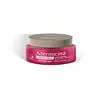What's inside
What's inside
 Key Ingredients
Key Ingredients

 Benefits
Benefits

 Concerns
Concerns

 Ingredients Side-by-side
Ingredients Side-by-side

Water
Skin ConditioningCaprylic/Capric Triglyceride
MaskingCetyl Alcohol
EmollientGlyceryl Stearate
EmollientPEG-75 Stearate
Ceteth-20
CleansingSteareth-20
CleansingPolyacrylate-13
Polyisobutene
Polysorbate 20
EmulsifyingC10-18 Triglycerides
EmollientJojoba Esters
EmollientHelianthus Annuus Seed Wax
Skin ConditioningAcacia Decurrens Flower Wax
EmollientPolyglycerin-3
HumectantPhenoxyethanol
PreservativeEthylhexylglycerin
Skin ConditioningNiacinamide
SmoothingXylitylglucoside
HumectantAnhydroxylitol
HumectantXylitol
HumectantSodium Hyaluronate Crosspolymer
HumectantSodium Hyaluronate
HumectantSodium Acetylated Hyaluronate
HumectantHydrolyzed Sodium Hyaluronate
Skin ConditioningTocopheryl Acetate
AntioxidantParfum
MaskingDisodium EDTA
CI 16035
Cosmetic ColorantWater, Caprylic/Capric Triglyceride, Cetyl Alcohol, Glyceryl Stearate, PEG-75 Stearate, Ceteth-20, Steareth-20, Polyacrylate-13, Polyisobutene, Polysorbate 20, C10-18 Triglycerides, Jojoba Esters, Helianthus Annuus Seed Wax, Acacia Decurrens Flower Wax, Polyglycerin-3, Phenoxyethanol, Ethylhexylglycerin, Niacinamide, Xylitylglucoside, Anhydroxylitol, Xylitol, Sodium Hyaluronate Crosspolymer, Sodium Hyaluronate, Sodium Acetylated Hyaluronate, Hydrolyzed Sodium Hyaluronate, Tocopheryl Acetate, Parfum, Disodium EDTA, CI 16035
Water
Skin ConditioningDimethicone
EmollientGlycerin
HumectantCetearyl Olivate
Polyacrylamide
Sorbitan Olivate
EmulsifyingPhenoxyethanol
PreservativeDimethicone/Vinyl Dimethicone Crosspolymer
Skin ConditioningSynthetic Beeswax
Emulsion StabilisingC13-14 Isoparaffin
EmollientDimethiconol
EmollientDimethicone Crosspolymer
Emulsion StabilisingChlorphenesin
AntimicrobialLaureth-7
EmulsifyingCarbomer
Emulsion StabilisingSodium Hyaluronate
HumectantEthylhexylglycerin
Skin ConditioningC12-14 Pareth-12
EmulsifyingSodium Hydroxide
BufferingWater, Dimethicone, Glycerin, Cetearyl Olivate, Polyacrylamide, Sorbitan Olivate, Phenoxyethanol, Dimethicone/Vinyl Dimethicone Crosspolymer, Synthetic Beeswax, C13-14 Isoparaffin, Dimethiconol, Dimethicone Crosspolymer, Chlorphenesin, Laureth-7, Carbomer, Sodium Hyaluronate, Ethylhexylglycerin, C12-14 Pareth-12, Sodium Hydroxide
 Reviews
Reviews

Ingredients Explained
These ingredients are found in both products.
Ingredients higher up in an ingredient list are typically present in a larger amount.
Ethylhexylglycerin (we can't pronounce this either) is commonly used as a preservative and skin softener. It is derived from glyceryl.
You might see Ethylhexylglycerin often paired with other preservatives such as phenoxyethanol. Ethylhexylglycerin has been found to increase the effectiveness of these other preservatives.
Phenoxyethanol is a preservative that has germicide, antimicrobial, and aromatic properties. Studies show that phenoxyethanol can prevent microbial growth. By itself, it has a scent that is similar to that of a rose.
It's often used in formulations along with Caprylyl Glycol to preserve the shelf life of products.
Sodium Hyaluronate is hyaluronic acid's salt form. It is commonly derived from the sodium salt of hyaluronic acid.
Like hyaluronic acid, it is great at holding water and acts as a humectant. This makes it a great skin hydrating ingredient.
Sodium Hyaluronate is naturally occurring in our bodies and is mostly found in eye fluid and joints.
These are some other common types of Hyaluronic Acid:
Learn more about Sodium HyaluronateWater. It's the most common cosmetic ingredient of all. You'll usually see it at the top of ingredient lists, meaning that it makes up the largest part of the product.
So why is it so popular? Water most often acts as a solvent - this means that it helps dissolve other ingredients into the formulation.
You'll also recognize water as that liquid we all need to stay alive. If you see this, drink a glass of water. Stay hydrated!
Learn more about Water